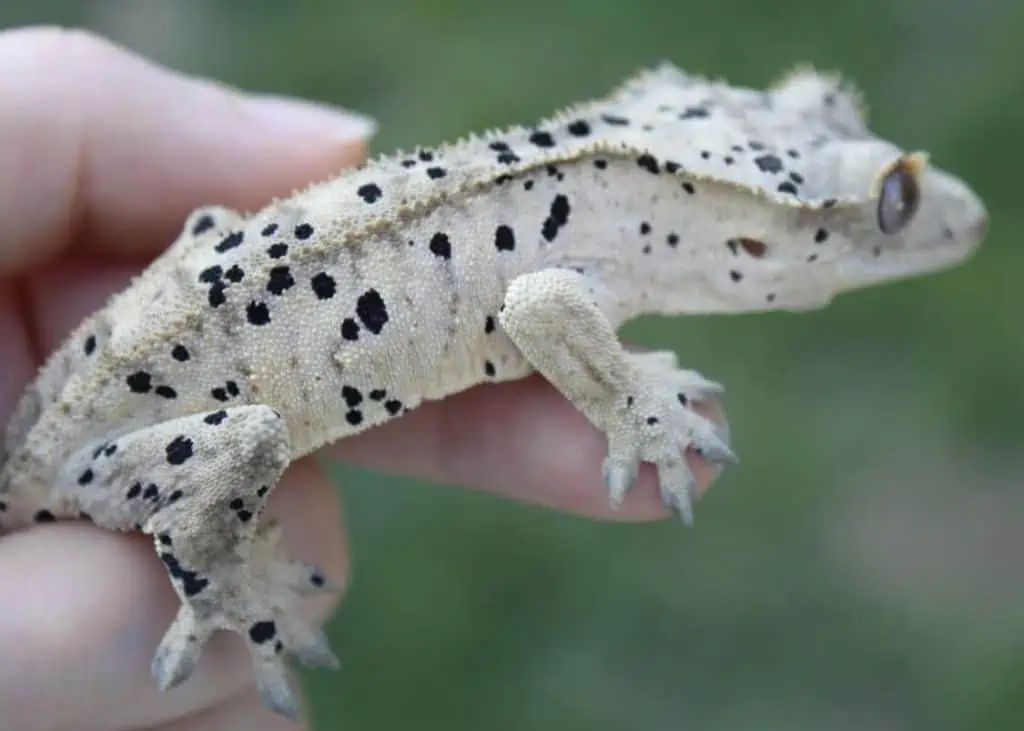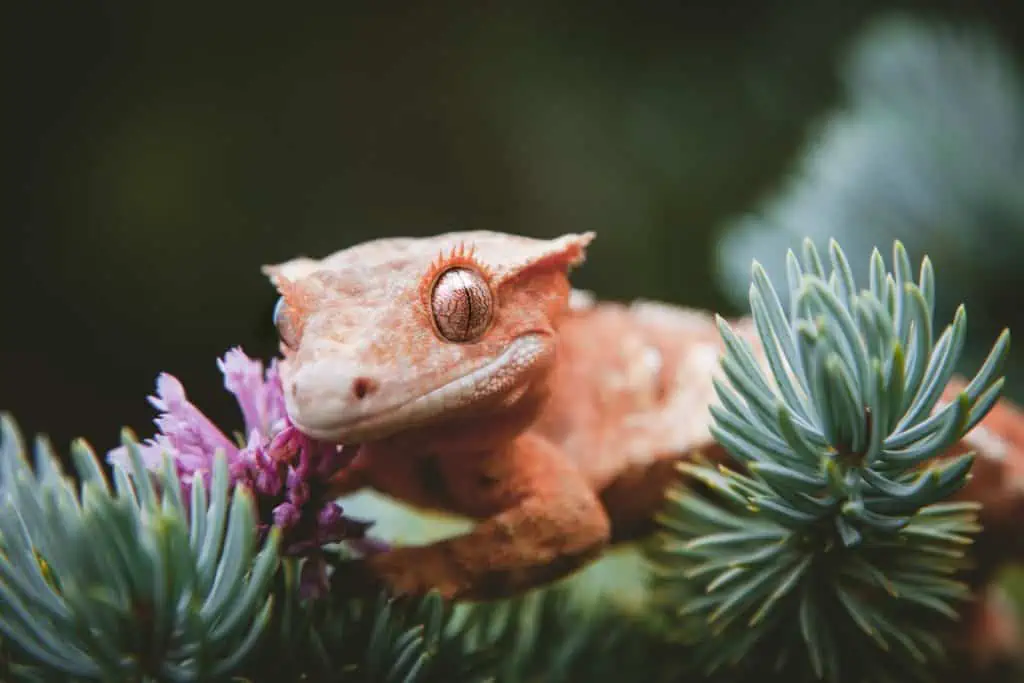Crested geckos are crepuscular and nocturnal creatures, meaning they’re active during the day and sleep at night. You must provide the right lighting setup to keep your gecko healthy and mimic their natural environment. This will help regulate their:
- Sleeping-patterns
- Aid in digestion
- Calcium absorption
- Overall well-being
Plus, you’ll enjoy your buddy gecko’s beautiful colors better than ever. You should give your crested gecko:
- 12-14 hours of daylight during the summer
- 10 hours in the winter
Though cresties don’t need any light after dark, there is some evidence that low levels of UVB exposure benefit them. Proper lighting is also vital to keep live plants in their tank.
Depending on your gecko’s needs, the right light can even help with bone health. So, it’s important to properly understand and fulfill their needs to provide them with a happy and healthy living environment.
Do Crested Geckos Require Lighting?
To understand the lighting needs of geckos in captivity, we must first study their natural habitat.
New Caledonia, located in the South-Pacific, is a tropical paradise with lush vegetation and wildlife, including crest geckos. These geckos inhabit three distinct areas:
- The Isle of Pines
- Blue River (Grande Terre)
- South of Mount Dzumac (Grande Terre).
The climate here is warm, with temperatures ranging from 68°F to 82°F (20°C to 28°C) year-round. Additionally, humidity levels can reach ~80% during the rainy season (November-April).
The natural landscape is mostly rainforest, providing plenty of hiding spots and trees for climbing. During the day, geckos usually sleep in the shady undergrowth, but at night, they come out to hunt insects and feed on ripe fruit. Sunlight filters through the canopy in some areas, but there is mostly deep shade and darkness.
Regarding light exposure, New Caledonia has an average of 10-14 hours of daylight per day. Crested geckos are most active during dawn and dusk, the twilight periods, meaning they don’t get much direct exposure to sunlight.
Thus, in captivity, too much bright light can be stressful for them. Instead, try to replicate the dappled sunlight of their natural environment with a suitable setup. This will help keep your pet happy and healthy.

The Importance of Proper Lighting
When caring for your crested gecko, proper lighting is often overlooked. However, light plays an essential role in the overall health of your pet gecko. There are four main reasons lighting fixtures can be helpful or even necessary.
1. Sleep-Wake Cycle
Crested geckos are creatures of habit. They need a light cycle to know when to snooze and when to stay up and about. You’ll need to create a day/night cycle for them in the terrarium to keep their biological clock ticking as it should. Without natural light, their internal clock can get thrown off track and cause them to become stressed.
2. Vitamin D3 Source
Vitamin D3 is essential for a reptile’s health. They can get it through supplements or food sources. But there’s also a natural way: by basking in the sun!
Reptiles have pro-vitamin D (or 7DHC) in their skin, which, when exposed to ultraviolet (UVB) rays, is converted into pre-vitamin D. Then, when the skin gets warmed up, it becomes vitamin D3.
It’s important to note that vitamin D3 plays the role of a hormone for crested geckos. In other words, even if the geckos are provided with sufficient calcium through their diet, without vitamin D3, they won’t be able to absorb it from the gut. This can lead to a very preventable condition known as metabolic bone disease.
In short, when calcium levels drop to dangerously low levels, the body compensates by taking calcium from the bones, making them weak and brittle—just like rickets do to humans.
Calcium is also vital for several bodily functions in crested geckos, such as:
- Muscle contractions
- Nerve function
- Hormone and metabolic function, etc.
And if there’s a lack of calcium, it can result in:
- Difficulty walking
- Violent seizures
- Even loss of appetite
That’s why ensuring your pet gecko has enough vitamin D3 in their system is crucial.
3. Stimulate Plant Growth
If you’re thinking of adding life to your terrarium with plants, there’s one essential you’ll need: light.
Not all plants indeed need intense light, but they do require some. Just like in nature, where sunlight provides a full illumination spectrum, your indoor garden needs the same. So, if you want your vegetation to thrive, remember: it’s all in the light!
🌿 Read more: Best Safe Plants for Crested Geckos
4. Promote Natural Behavior
Proper lighting is a must for your crested gecko. You’ll be delighted to see their natural behaviors come out, such as foraging and exploring. Without it, your gecko may become sluggish.
You’ll love watching them come alive and alert with the right lighting! So don’t forget to get the proper lighting for your gecko; it’ll make all the difference.

What Kind of Lighting Do Crested Geckos Need?
Choosing the right lighting for your scaly pet can be difficult due to the many available options. To help you make an informed decision, I’ve provided information on the different types of lighting, their benefits and drawbacks.
UVA (Ultraviolet A) Lights
UVA light is essential for your crestie’s health and well-being: it replicates the natural illumination of their environment, assists in behavior management, and helps with natural behaviors like eating, breeding, and basking. All of which are key to keeping them happy and active.
UVA radiation has a higher wavelength (315-400 nm) than other UV rays but a lower energy level. This light should be used in small amounts to help regulate their circadian rhythm and mimic their natural environment. You don’t want your crestie getting too much of a good thing!
With the right amount of UVA light, your reptilian buddy will stay healthy, mentally stimulated, and full of life.
UVB (Ultraviolet B) Lights
It is essential to provide your companion with UVB lighting, as we now better understand the species and their natural habitat. The wavelength of UVB light ranges between 280-320 nm. It helps their bodies absorb and utilize calcium properly, keeping their bones strong.
But here’s the thing: Since they are nocturnal, they don’t get much natural exposure to UVB in the wild. That’s why you need to provide them with a low-level UVB bulb. However, it’s not necessary if you supplement their diet with the right vitamins and minerals.
Finding the balance that works for them is key. After all, every crested gecko is unique!
UVC (Ultraviolet C) Lights
UV-C lighting (wavelength ranging between 100-280 nm) won’t do a thing to benefit your beloved crested gecko or any other type of reptile or animal. While it does help kill bacteria, meaning it can be used to give the tank a thorough, deep clean.
LED Lights
LED lighting is a great option for your crested gecko’s enclosure. Not only does it provide beautiful illumination – making their home eye-catching in your room – but it also doesn’t produce heat like other light sources.
So you won’t have to worry about the temperature fluctuating. Sure, LED lighting won’t give any special health benefits like UVB and UVA lights, but it does provide a day and night cycle; you can rest assured your gecko won’t be uncomfortable.
Just make sure it’s not too bright for them! After all, their comfort should be your main priority.
Infrared Lights
You may encounter infrared lights as an alternative choice. Marketed as a heat source that can be used during the night without disrupting your gecko’s sleep, they’re not always necessary. As long as the temperature doesn’t dip too low, crested geckos don’t require extra heating.
Be aware that they’re able to detect the red glow from these lights, so it’s best not to use infrared ones for your cresties.
Choosing the Right UV Bulbs
There are two main styles of UV lights for reptiles:
- Compact bulbs, coiled like an old-school light bulb.
- Longer strip lights are more suited for larger vivariums.
When picking out a good UV bulb, ensure it provides the right spectrum of UVA and UVB while avoiding UVC. Stick to reputable brands like Exo Terra, Arcadia, Zoo Med, etc – don’t be tempted to go for generic, cheap bulbs that haven’t been properly quality checked.
You won’t regret spending more on a trusted product that will keep your pet safe and sound.
Plus, technology has improved so much that UVC isn’t an issue. When looking at the package labels, make sure it says “UVB”, which means it includes UVA too.
Strength of the Bulbs
The next thing to consider is strength: how much of that spectrum do you need?
Bulbs are usually rated in % and watts. Some brands even have their own rating systems, so you’ll need to know which is yours. But when it comes to Crested Geckos, you can safely stay on the low side.
Fluorescent bulbs typically come in “2.0”, “5.0,” and “10.0” versions: the numbers represent the UVB output.
Both “2.0” and “5.0” are OK. Just make sure to keep your light at a safe distance from the gecko’s basking spot.
- A 2.0 will work just fine for an average crested gecko habitat.
- And if you’re using a 5.0, it should be placed far enough away to stay safe.
But steer clear of the “10.0”. That’s only for desert species or very large terrariums.
Choosing a UVB light for your crested gecko can be overwhelming, but I’ve got you covered.
- Zoo Med ReptiSun 5.0 Mini Compact Fluorescent Lamp is your best bet. This fluorescent will provide both UVA and UVB light in low amounts.
- Another good option is the Exo Terra Repti-Glo 5.0, you can pair it with domes like the Exo Terra 15cm aluminum fixture or Zoomed Mini deep dome.
- If you want something even better, get the Arcadia ShadeDweller 2.4% Arboreal ProT5 Kit which comes with a shield to sit nicely on your vivarium. And you can even couple it with the Jungle Dawn LED kit (best for illuminating your pet’s tank). Don’t worry if you don’t get it. Here’s a video to give you a better picture.
How To Properly Install Lighting in a Terrarium?
Now that you have the light bulb, the next step is to install it in your terrarium. When setting up the lighting system, you have two fixture options to choose from: a dome lamp fixture or a canopy fixture.
- A dome lamp fixture is fitted on top of the terrarium and is a popular choice from brands like Repti-Zoo, Zoo Med, and Fluker’s.
- Alternatively, a canopy fixture is ideal for compact fluorescent bulbs and is best suited to larger terrariums.
If none of these options suit you, you can also use a lamp stand.
Screw in the light bulb and fasten the fixture to the terrarium walls or at the top with a hook or clamp. When setting up the lighting system, you should keep a few important points in mind:
- Place the light(s) at the top of your crestie’s terrarium in order to simulate natural sunlight. If your terrarium is larger, you may need more than one light to ensure the entire space is well-lit.
- Make sure the light is placed in a position where any glass or plastic doesn’t filter it. Most terrariums have screen-tops that allow the UV light to pass through.
- Position the lamp in a way that provides direct light to your lizard gecko but keeps the bulbs out of their reach. This is especially important when using a heat-emitting light. Additionally, make sure the lights cannot touch anything flammable, such as paper or leaves.
- Ensure the lights are securely fixed in place and can’t fall into the terrarium.
Crested Gecko Lighting Schedule
When using artificial lighting to provide your crested gecko with the proper light levels, it is important to create a consistent lighting schedule. This is true both during the day and night.
UVB Lights
It is not necessary to keep the UV light on all day long for your buddy geckos. These geckos usually get UVB exposure indirectly in their natural habitat, such as through light passing through leaves or reflecting off surfaces. The recommended duration to keep the UVB lights on is around 4 to 6 hours per day, regardless of the season.
LED Lights
Your gecko has a day-night cycle, like us humans. To keep it consistent, turn your LED lights on for 12-14 hours in the summer and 10 hours in the winter. To make it easier you can set a timer, it’s an absolute lifesaver!
Do Crested Geckos Require Additional Light During Nighttime?
No, crested geckos don’t need light at night. In fact, you should keep the lights off: it’s when your nocturnal crestie is most active. Keeping the lights on will disrupt their sleep cycle and could lead to more sleep, lethargy, poor health, and a grumpy gecko.
Consider getting a night vision camera if you want to monitor your crestie’s night-time activities. A good one is the Wyze cam: it’s cheap, reliable, and easy to use.
Important Tips To Remember
To ensure that you are providing the proper lighting for your little pet’s terrarium, these tips and tricks will help you make the most of it:
- Avoid Direct Sunlight: As the terrarium’s glass will filter out light but keep in the heat, direct sunlight can cause temperatures to rise above 85°F instantly, leading to heat stroke. So steer clear of windows and direct sunlight!
- Be Mindful of Incandescent Bulbs: If the temperature in the terrarium is at its ideal range, you don’t need to provide extra heat. However, keep an eye on how hot incandescent bulbs can make the terrarium, as this could be detrimental to your gecko.
- Avoid Blacklight (UVA) Bulbs: These can cause severe damage to your crested gecko’s eyes, skin, and immune system due to the intense rays they emit. Thus, it’s vital to pick the right kind of lighting!
- Steer Clear of Mercury Vapor or Halogen Bulbs: These kinds of bulbs also generate heat and may stress out your crested gecko. Smart placement in a cold environment might work, but mercury-vapor lights only last so long, so you’ll need to replace them eventually.
- Maintain Proper Temperature: Monitor your crestie’s tank’s temperature via thermometer, as some lights can heat up the tank. Maintain it through regular misting.
Overall, the right type of lighting is essential for keeping your crested gecko healthy and happy.
It’s Your Turn!
You can’t skimp on quality when it comes to crested gecko lighting needs and requirements. The wrong lighting setup can be dangerous and stressful for your gecko. Get the products that are designed specifically for cresties. You should always pick a setup with UVB and UVA lights and place them at the appropriate distance from your scaly pet.
Have you set up the correct lighting for your crested gecko? What kind of products have you used? Share your experiences with us in the comments section below!



